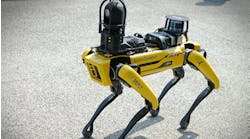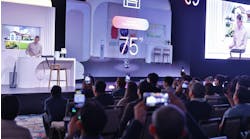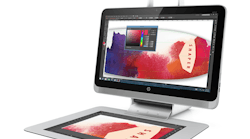The Microsoft HoloLens starts shipping at the end of the month, and tech enthusiasts everywhere can’t wait to strap on a headset and dive into a world of holograms and endless possibilities. While I can’t wait to dive in this brave new augmented world, I have recently dipped a toe into blended reality, a term HP Inc. coined in 2014 with the introduction of Sprout, a computer which places the power to turn the physical into digital, and vice versa, right at your fingertips.
HP had a Sprout demo trailer stationed inside Cleveland’s Wizard World Comic Con this past February, and what was inside was more amazing than all the costumed Spider-Man attendees combined .
There were several 23-in. touchscreen monitors, yet not a keyboard or mouse or mouse in sight. There was, however, a RealSense 3D camera and projector, called the Illuminator, hanging over each monitor. This has the ability to project the virtual keyboard of your choice on the touch mat. My stepdaughter chose a piano keyboard to play a few chords of “Imagine,” an impressive feature to 13-year-old, though this exercise would cause the Intel Core i7 processor barely break a sweat.
The real “wow” factor comes from the Illuminator’s ability to 3D scan objects on the touch mat and display them as digital renderings on the screen. This model can be altered using editing software such as Microsoft 3D Builder or Autodesk Meshmixer and sent to a 3D printer when ready. A Dremel 3D Idea Builder was stationed in the corner, printing out various Star Wars figurines, to demonstrate how the process works to the uninitiated.
As a commercial product, it’s cool and can acclimate the next generation to 3D printing in the most hands on way possible. After a year on the market and feedback from users, HP has started to more fully understand its potential in education and manufacturing, realized in the enhanced Sprout Pro, now available.
“Sprout Pro adds tools for creative professionals, students and instructors to the ground breaking Sprout platform,” says Louis Kim, global head and general manager of Immersive Computing, HP Inc. “Instant 2D/3D scanning, augmented reality and an immersive dual screen is now boosted by pro-class applications and security - accelerating workflows and safeguarding data.
Allen Buckner, director of global product management for Sprout Pro, points to three major improvements “to quickly bring and share physical objects into the digital realm while doing a live conference.”
1. Upgraded scanning applications allowing professional-level scanning of documents and images, with controlled exposure and optical character recognition.
2. The External Display Mixer software, which allows you to show an audience, one or all four devices: the vertical and horizontal screens, video from the webcam, or from the downward facing camera.
3. Sprout Companion for Skype for Business is the application that shares the real-time data and video during a live conference.
The features Buckner pointed to, powered by an Intel Core i7 processors with DDR4 memory and using Windows 10 Professional as the OS, creates a dynamic new workspace. HP says its primary focus is as an educational tool.
You may have learned much of your trade from a professor writing on a chalkboard or using an overhead projector with markers transparent plastic sheets. Or more recently, from a laptop connected to ceiling-mounted projector. By comparison, Sprout Pro is like entering The Matrix.
“This could be a tool that will help ignite the minds of the folks in the future that are going to be working in our factories and driving our processes,” explains Allen Buckner, director of global product management for Sprout Pro.
As for professionals, the rapid prototyping applications could speed up innovations in unimaginable ways. Instead of waiting for emails to see pictures or having to meet in person, collaborators can jointly work on a model despite being thousands of miles apart.
For now Sprout Pro is just breaking the surface, and can bloom into any number of applications. Leveraging the software development kit, one company, OPS Solutions, has created an augmented reality tool called Light Guided Systems Pro, to speed up and improve assembly processes by projecting the instructions directly on a circuit board, for example, so the worker doesn’t need to refer to a monitor or manual.
How would you use Sprout Pro to improve your 3D printing and innovation processes? Let us know in the comment section below!











